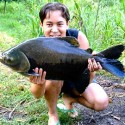Explore Articles Filed Under: Indigenous Culture

I have argued that the Upper Amazon is the center of a larger culture area uniquely characterized by the use of psychoactive plants and mushrooms in the practice of shamanism. A number of people offered the counterexample of iboga (Tabernanthe iboga) in the Bwiti religion as a shamanic use of a hallucinogen outside this extended culture area. Now, there is no question that psychoactive plants and fungi are widely used in indigenous cultures around the world. The question we are asking, however, is not whether they are used, but whether they are used by shamans for shamanizing. And that raises a number of considerations.

There are a number of places in the Upper Amazon which are particularly good for finding fish. Large and medium-sized rivers in low areas often form numerous meanders which, when the river changes course, become cochas, oxbow lakes. These cochas often have sediment settled on the bottom, relatively clear water, and high temperatures, and therefore rapid plant growth, which in turn supports quite large fish populations. Sometimes too you can see strips of clear and very slow water in a river. These are quiet places where plankton tends to grow; you can usually find fish downstream. You can also find fish under camalones, places where aquatic vegetation has formed a dense mat on the surface of the water. And fish love to move into the waters covering seasonally flooded forests.

Artist Luc Perez has completed a new eleven-minute animation entitled Shaman, to be released as a French-Danish coproduction from Danske Tegnefilms and 24 Images. The story begins in modern Copenhagen, where Utaaq, an old Inuit, sits at a bus stop. He sees a bird from his native Greenland — rare in Denmark — and he remembers a great battle he once had with a wicked sorcerer who used a tupilak — an avenging monster fabricated out of animal parts — to kill other hunters.
One of the most striking features of Amazonian mestizo shamanism is the icaro, the magic song, whispered, whistled, and sung. The shaman uses icaros to call the spirits for healing, protection, or attack, and for many other purposes as well — to control the visions of another person who has drunk ayahuasca, work love magic, call the spirits of dead shamans, control the weather, ward off snakes, visit distant planets, work sorcery.

There are two families of venomous snakes in the Upper Amazon — the Crotalidae or pit vipers and the Elapidae or coral snakes. The Crotalidae are called pit vipers because they have a pit or depression between the eye and the nostril on each side of the head, which functions as an extremely sensitive infrared heat-detecting organ. In the United States, there are three genera of the Crotalidae family — the copperhead, the cottonmouth or water moccasin, and fifteen species of rattlesnake.

The National Museum of the American Indian — part of the Smithsonian Institution — is sponsoring a film festival with the title Vídeo Amazônia Indígena: A View from the Villages, which will showcase award-winning productions by indigenous videomakers of the Brazilian Amazon. The showcase is intended to honor the work of the independent media organization Vídeo Nas Aldeias (VNA), Video in the Villages, which for twenty years has provided video training and production support to indigenous mediamakers in the Brazilian Amazon.

There is a Greek word, hamartia, which is usually translated as tragic flaw, although it connotes more a cognitive than a moral failing — the lack of an important insight, a misperception, a blindness, a failure to perceive ethical and spiritual consequences. The idea of hamartia is often ironic; the very strength that makes the protagonist a hero is what brings about disaster.
There is a theme woven through the shamanisms of the Upper Amazon — that human beings in general, and shamans in particular, have powerful urges to harm other humans. The difference between a healer and a sorcerer is that the former is able to bring these urges under control, while the latter either cannot or does not want to. Thus, what distinguishes a healer from a sorcerer is self-control.
The spirits must have planned this, because just after I published a post on two coyote poems, my delightful grandchildren came to visit, and climbed up on my lap, saying, “Grampa, grampa, tell us a coyote story” — all except for Avi, who doesn’t say much, because, by the time he gets around to saying something, his two older sisters have already said it. I said to my wonderful grandchildren, “All right, my moppets, I will tell you the story of coyote and the assholes.”

Coyote the trickster — generous and greedy, crafty and impulsive, clever and reckless — is not dead yet. Coyote is the great cosmic creator and the clumsy destroyer — as literary critic Franchot Ballinger puts it, “a force of multifarious creative energy.” Coyote is killed, chopped up, crushed, and destroyed, yet always comes back to life, sometimes wiser and sometimes not, just like the indigenous peoples of North America who created him.

Discussing the article:
Hallucinogens in Africa